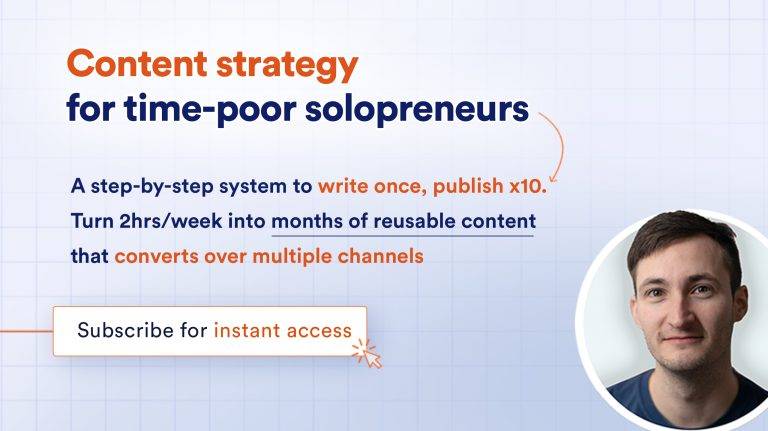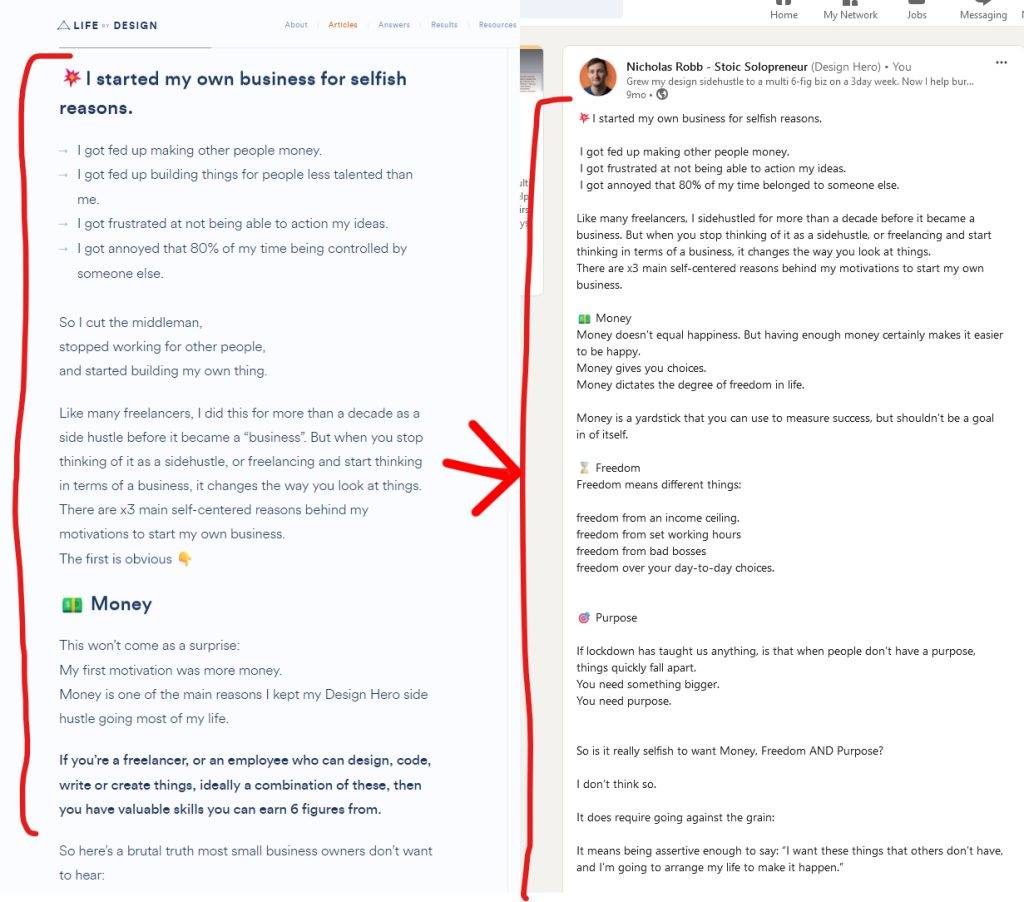I realised I was making a huge mistake on my social this week.
I logged into Linkedin to see my stats with a sinking feeling:
There’s nothing worse than putting in the time and effort,
but seeing a continuing trend of dropping engagement.
After going down the rabbit hole (is it me? is it my content? why?!)
I then stepped back and spent some more time in the garden,
so I had time to realise my mistake…
I was following advice from a few gurus who were doing well.
As usual, what works for them wasn’t working for me:
I was selling in every post,
I was trying to give value all the time instead of posting what I wanted to (human element)
I had stopped engaging with others to focus on my own content
So after some initial success on some viral posts, my growth and engagement died.
There’s a lot more to it, but you can boil down success on social to just 2 things:
Consistency
Relatability
In my quest to come up with the perfect system for consistency, I had lost my relatability.
What’s needed is less thinking and less formality, and to go back to my earlier content where I was mostly just posting about my daily life running a lifestyle business.
A meme from my man Colby Wetger summed it up perfectly:

But let’s not over-correct here;
as the stoics would say; balance in all things.
There’s a happy middle ground:
You need a strategy and structure for consistency,
but you also need to allow for posting what you want,
otherwise I’ll turn into robot spouting wisdom from a pedestal.
The bit I struggle with on social is being constantly social.
It’s not a natural state for me.
I like to retreat to my little garden office and write and think like a hermit,
and pop out occasionally for a chat and a coffee, like some kind of nesting turtle 🐢
Engaging on social media can feel like a burden to me.
It’s a shame I decided to run an education business that lives on social media 🤣
But I enjoy the writing part.
A strategy and a system for social media, for solopreneurs who hate social media 😅
A word of warning before we dive in.
When you implement this system you will have so much content that you won’t be able to publish it all.
At this point your problem is not generating content, its deciding which content to publish.
There will never be enough content to satisfy the algo.
So decide what “enough” looks like, then stop.
This is why it’s important to have a system.
My system is a step-by-step process built around long-form writing.
x1 newsletter = 1 week+ of posts
I write once, repurpose x10, and turn 4hrs/week into lasting content that converts,
to build an engaged audience over multiple channels.

How to create content that converts to an engaged audience over multiple channels in just 2hrs/week
Subscribe for instant access to my content strategy + social system for time-poor solopreneurs who hate spending time on social.
0:00 Why I struggled to get traction
1:20 Long-form content creator strategy
1:50 Write in IP (intermediate packets)
2:15 Turn long-form into short form
3:00 Repurpose your chunks
4:00 Editing for readability
4:30 x7 posts in 10mins
5:00 🪙 build a content library
6:00 each peice of content is a long-term asset
6:30 Building a content strategy
7:00 content schedule
7:20 TOFU, MOFU and BOFU
7:40 Content types
8:30 Using templates to accelerate production
9:20 Use frameworks to stay consistent
10:00 managing expectations
Social Strategy for Solopreneurs
Most people don’t create, only consume.
Some people write only short form on social media.
Only a few people write medium form such as newsletters.
Fewer still commit to long form.
All the top 1% of creators are doing some type of long-form content.
So that’s what I’m doing.
It’s harder. It takes longer. At first. But actually it’s far more productive.
Allow me to explain why it’s worth your while…
Your content is a body of work larger than yourself.
It’s your thoughts, values and life’s work.
The lifespan of a piece of social content is measured in hours and days.
A blog is forever, and builds authority over the years,
and can be repurposed into shorter form content.
A short-form piece of content is a perfectly distilled value bomb with all the fat trimmed out.
The opposite doesn’t work,
You can’t add depth to a short form post,
lengthening it will only add fluff.
So my content strategy is a waterfall strategy from long-form to short form.
The Content Strategy
I write high quality, long form content on https://lifebydesign.online/blog/
which is then repurposed for social
which leads people into my workshops, free resources and lead magnets
which leads new audience members back into the newsletter (long form content)
It’s a circle ⭕

Update: I’m no longer posting on Insta.
I loved stories I could share moments from my day and life, the low production value behind the scenes stuff.
But I hated everything else about it.
Creating high production reels in my niche were a major time suck.
Plus I have a face made for twitter 👺
I’m x10 happier after ditching everything else to write instead.
Write Social Media SOPs for yourself
Every month your head is going to be on different things,
So it will help your consistency to answer a few questions to direct all of your efforts on social.
If you haven’t already, go through the process of writing out answers to the questions below,
These will become a new SOP for your one person business called “📃 Social Strategy SOPs”.
I’ve included my answers from my own SOPs below for you as a example:
What is my content
Content to help freelancers become solopreneurs by
- designing their ideal life
- build a lifestyle business
- scale it with systems
Why I write
- Grow an audience for my newsletter
- sell coaching calls
Who I write to
What role your one person is?
- solo or freelance designer
What problem you help them solve?
- systemize the business to build leverage for profit, freedom and higher purpose
What emotional state are they in?
- ambitious but overworked, frustrated and burned out
3 characteristics
- Driven, talented, busy
- I help frustrated 5 figure freelancers become systemized solopreneurs, to systemize a 6 figure solo business for a 3 day workweek without burnout.
Pain points
- They have been trying without success.
- They work all the time but don’t earn enough
- They have no free time despite working for themselves
- They want control over their own life.
- They lack clarity on what to do next.
How do I want to be seen?
- An authority on lifestyle business, but I don’t want to take the subject too seriously
- I don’t know everything and I’m not trying to be a BS guru.
- I’m sharing the systems I used to scale their profit and freedom without burnout.
Content Funnel
It will also help you to be aware of which stage of the funnel you’re writing to.
This will change your goal and your writing style.
The deeper down the funnel you go,
the more specific your target reader.
the narrower your focus should be
You can assume more technical language or more expert level knowledge.
Copy the below and add it to your 📃 Social Media SOPs
|
TOFU – Awareness
|
Unaware of the problem,
or that problem exists
|
Any knowledge workers running a solo business
|
|
MOFU – Interest
|
Aware of problems,
unaware of solution
|
Freelancers wanting to scale a profitable solo business without burnout
|
|
BOFU – Desire
|
Problem aware,
solution seeking
|
5-figure freelancers with steady clients who want to scale to 6 figures on a 3 day workweek by systemizing their business
|
Content Pillars
Finally, note x3 areas of interest that you talk about.
Under these list topics
under each topic you can list pain points around that topic.
If you’re ever stuck for content ideas you can come back to this and simply pick a pain point to write about:
Add this to your 📃 SOPs
|
Lifestyle Design
|
Stoic Solopreneuring
|
Lean Leveraged Business
|
|
Quitting the status quo
|
Your WHY
|
Systems
|
|
Intentional living
|
Combining work and life
|
Strategies
|
|
Time to think
|
Motivation
|
Productivity Tools
|
|
3 day workweek
|
Burnout & Overwhelm
|
Time management
|
|
Fulfilment and purpose
|
Stress
|
Automation
|
|
Routines and schedules
|
Sales
|
|
|
Why money doesn’t matter
|
Schedule
|
DAY
|
TEMPLATE
|
GOAL
|
FUNNEL
|
|
Mon
|
Client Transformation
|
💵 Sales
|
BOFO
|
|
Tue
|
Personal story / realisation
|
📈 Growth 🤝 Relate
|
TOFU
|
|
Wed AM
|
Repurpose LBD
|
👑 Authority
|
MOFU
|
|
Wed PM
|
Pre-Newsletter LBD promotion
|
📈 Growth
|
MOFO
|
|
Thu
|
Client Testimonial
|
💵 Sales
|
BOFO
|
|
Fri
|
Repurpose LBD
|
👑 Authority
|
MOFU
|
|
Sat
|
📹 Q&A Reels
|
👑 Authority 💵 Sales
|
MOFU
|
|
Sun
|
📹 Daily Reminder for Solopreneurs
|
📈 Growth 🤝 Relate
|
TOFU
|
How to repurpose content
I’ve been writing every day for 8 months and my writing style has totally changed.
Instead of freeform, I now write with repurposing in mind.
Each section of my long form content can be picked out and reworked into a med or short form peice of content.
Ironically, this brings more structure and order to my writing, so it improves my writing too.
Every paragraph you write can be remoulded and repurposed for later use.
Build a content library
The secret sauce is the content library
I rarely publish direct to social media.
I save all my posts in a PKM or Personal Knowledge System (also known as a second brain), such as Notion or Clickup
This takes more time initially but quickly becomes your most valuable asset.
I can search for these to repost, or to use snippets as comments, or for DMs.
I save everything from journal entries, notes, SOPs, contacts, social posts, research into my second brain for later use. it all connects and cross links to pollinate endless ideas.
This is a complete record of all the thoughts you’ve ever had and everything you’ve ever written which can be queried, searched and repurposed at any time for any use.
In Build a Second Brain, by Tiago Forte, he calls these “intermediate packets”.
The power of these IPs will open your mind to a new way of thinking and doing:
It’s not just rewriting your newsletter for social posts,
- You can reuse your IPs for linkbuilding,
- or for podcasts,
- or as mini courses,
- lead magnets
- and much more…
The SOPs I wrote to myself about hiring for my team, later become a long form newsletter about a low risk method to hire a dream team.
Some snippets from my daily journal became a framework for managing burnout.
If one of my coaching clients asks me a tricky question, in seconds I can search, find and drop a link to an indepth guide, a Youtube masterclass, a template or an FAQ they can plug into their business to solve their problem.
That’s the power of a second brain.
If this has got your brain spinning, check out this guide to building a second brain
Change your thinking to use Intermediate packets
This will be a whole blog post later but here’s the basics…
The template that I use to start every newsletter comes prefurnished with headings for me to write under,
with a list of posts I need to create from that newsletter,
hooks for using for the lead magnet,
a design template for the cover
Etc.
So when I open up to write,
I write,
without being distracted by admin or setting up, or thinking too much.
- First I have x1 big idea, which I get by re-examining my notes in my second brain, whatever has surfaced throughout the week.
- I chew on it over a walk.
- I write an outline of main headings.
- I write a few bullet points under each heading.
- I get back and search my second brain on Clickup for any articles, posts, newsletters, journal entries, brainfarts related to my idea, dropping interactive links into the main newsletter. These are my IPs.
- I reorganise my IPs into a narrative
- I By the end of a week, the post has mostly written itself, I just need to edit, connect the IPs with bridging statements, add a personal reflection at the start, and find a suitable lead magnet that fits the post (or create one)
My repurposing process
It’s a reverse of the above.
1. I take each section of the newsletter, pull them out and save as social posts in my second brain.
a. Remember the repurposed posts must make sense as a standalone post!
b. So you may need to rewrite or summarize, add connecting lines, add a hook etc.
2. Create the following posts from each section of the newsletter, filtering them through your content pillars, funnel and post types
3. I use my content schedule and strategy to guide my thoughts and repurposing:
a. 
Examples
- Here’s a post I repurposed from this article
- Here’s another post I repurposed from this article

This actually is tricky to describe in words, so I’m going to drop a link to my video walkthrough again which explains the process step by step with examples:

How to create content that converts to an engaged audience over multiple channels in just 2hrs/week
Subscribe for instant access to my content strategy + social system for time-poor solopreneurs who hate spending time on social.
- 0:00 Why I struggled to get traction
- 1:20 Long-form content creator strategy
- 1:50 Write in IP (intermediate packets)
- 2:15 Turn long-form into short form
- 3:00 Repurpose your chunks
- 4:00 Editing for readability
- 4:30 x7 posts in 10mins
- 5:00 🪙 build a content library
- 6:00 each peice of content is a long-term asset
- 6:30 Building a content strategy
- 7:00 content schedule
- 7:20 TOFU, MOFU and BOFU
- 7:40 Content types
- 8:30 Using templates to accelerate production
- 9:20 Use frameworks to stay consistent
- 10:00 managing expectations




















